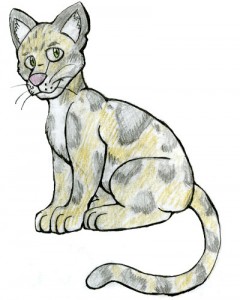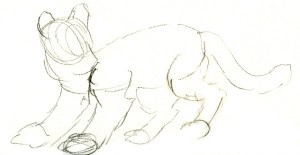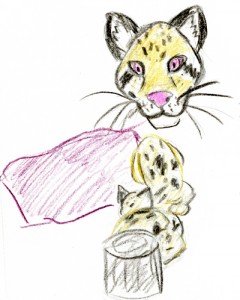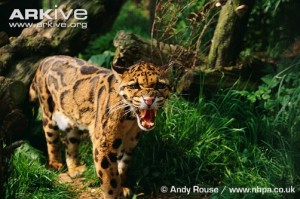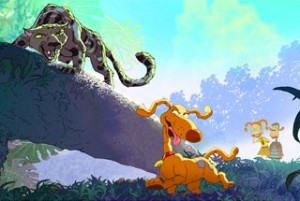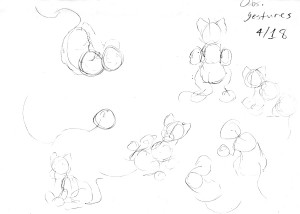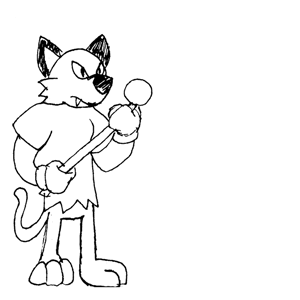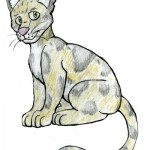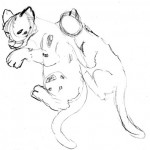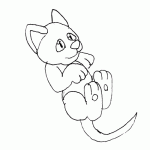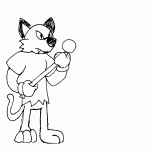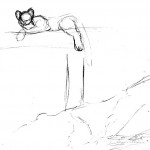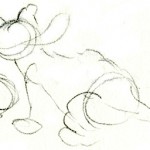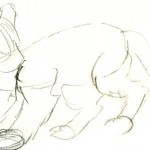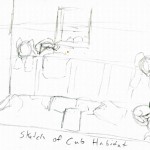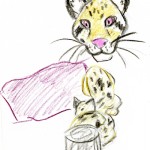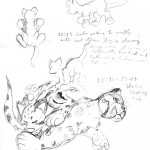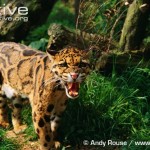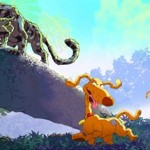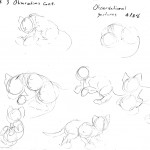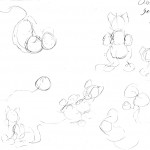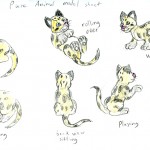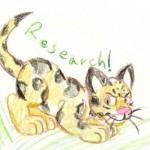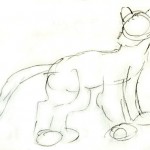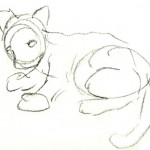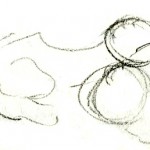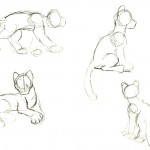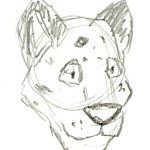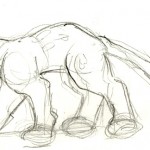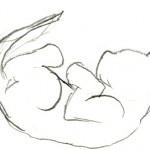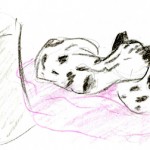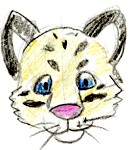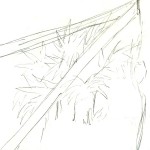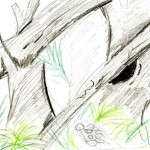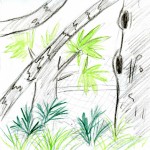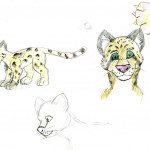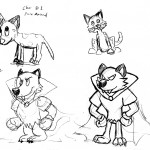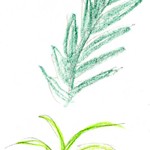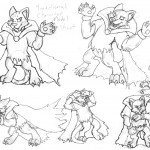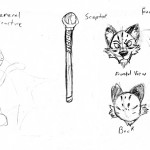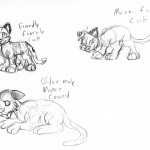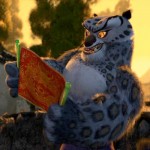Neofelis Nebulosa
Wikipedia Page
Kingdom: Animalia
Phylum: Chordata
Class: Mammalia
Order: Carnivora
Family: Felidae
Genus: Neofelis
Species: Nebulosa
Region: Southeast Asia (detailed areas found under Natural History)
INTRODUCTION
The animal I have chosen is the clouded leopard, or neofelis nebulosa. Originally, I had hoped to observe the adult male, Chee-wit, at the Point Defiance Zoo, but due to the lack of availability, I decided to focus on their two cubs, Chan-sung and Suksn. Chan-sung is the male cub, identifiable by his larger size and spottier coat. His sister, Suksn, is not only smaller, but bears a Y-shaped stripe that runs down her back, making her generally identifiable most of the time when the two cubs are crawling along the floor. As for how I observe these cubs, I tend to watch through the window into the cub den and record notes, make sketches, and speak with the keepers, volunteers, and interpreters for additional information.
I don’t know these animals on a personal level, since they’re kept in the cub den, and I’m merely an observer. However, during these eight weeks of watching them I have learned a great deal about the two cubs, from their personality to their habits, and even the way they eat their food. All this and more will be covered within my notes, and I hope you’ll enjoy coming along with me through both my book and eBestiary page, both of which chronicle my expanding knowledge of not only the cubs, but their species, too.
As for whether the cubs are solitary or group animals, I’ve learned that clouded leopards tend to be solitary in the wild. However, these two cubs stay together in their den, and so I consider them as part of a small group. Luckily, they’re easy to distinguish for reasons I’ve already covered, but my observations do cover the two of them as a whole. My reasoning is because these cubs are always together, and so their interactions with one another are a centerpiece of my notes and, indeed, the exhibit at the zoo.
Lastly, I chose to observe clouded leopards because I’ve always been fascinated with big cats. One of my original choices for the observation was the Sumatran tiger, but since tigers are so well-known across cultures while clouded leopards are more elusive, I felt that I would have more to learn by studying a more endangered cat. Not only that, but the chance to watch cubs grow over time seemed like an excellent opportunity that I simply couldn’t pass up. As of now, I can safely say that I made the right choice.
OBSERVATION EXCERPTS
Here are some samples from my observation notes, taken from a few different weeks to show the progression of the cubs’ growth and what I learned during this eight week journey.
Week 2:
This was my first week with the cubs and the only time I got to see Chee Wit for an extended period of time. At this point, the cubs were very tiny, but still full of energy. They stumbled rather than walked, and they couldn’t jump very high. Here are some snippets from that week…
- The male adult rests on a beam. He then proceeds to climb down onto the top of a cave and peers towards the bushes. It pokes its head towards a window.
- He returns to the ledge and lies down. People crowd around the exhibit. The zookeeper explains that he is the uncle of the new cubs.
- The cubs rest silently and still. There are two cuddled close together.
- One of the cubs twitches slightly and continues to sleep. The two cubs begin to twitch, but they continue to rest. More people gather around.
- The adult male now sits with his ears back, glancing around the enclosure. A minute or two later, he lies back down.
- One cub wakes up and proceeds to look around. The crowd grows, and there are many kids among them.
- The adult walks down one of the logs and approaches the window. He leans against the window, hops down, and climbs back up. He faces the crowd and lets out a hiss. Then, he hops down a few times and eventually crawls through the window.
-
I see the cubs crawling around. They stay close together, close to the corner. One cub crawls along a little log. The other crawls towards a keeper, who scoops it up. The keepers rearrange their bedding.
- One cub tries to slip out the door, the other stays near the wall. As the keepers clean them, they start to squirm.
- The cubs have huge paws and stumble as they walk. One cub plays with a stuffed tiger, the other sits by the door. The other cub approaches and initiates play, eventually returning to the toy tiger.
- It’s amazing to see these cubs so active; I’ve never seen anything like it. They try to jump, but don’t get very high. One cub rolls onto his side.
Day 2:
- I catch a glimpse of the adult in the back window. He takes a quick look and runs off.
- Andy gets him to come up to the window, and he watches the crowd. He stays for about a minute before he wanders off. A kid bangs on the glass, and the volunteer asks him to stop. Luckily, the cubs continue to sleep.
- The volunteer explains that the adult male, Chee Wit, is very attached to the keeper Andy. He apparently comes up a lot during feeding time. He is also the only adult who ventures into the large enclosure.
Week 4:
By this week I’ve learned the names of the two cubs, who have grown considerably. They’re more active, and I get a good look at the way they play and interact with the keepers.
10:04 Chan-sung wraps his paws around the keeper’s arm and sticks out his tongue. The keeper scratches his belly and plays with his back feet. Apparently he’s a finalist for a cutest baby contest of the year award, which may fund conservation efforts. The other keeper rocks his sister, and she bats her paws.
10:15 Chan-sung pounces into the keeper’s lap, and she plays with him using the plush tiger. He kicks his feet and nips at the toy’s neck. Suksn, meanwhile, rolls onto her back as a keeper puts food in her mouth. She gets up, wanders, and looks at the front window.
10:35 I finally get closer and hear Suksn squeak. One of the keepers holds her close and pats her on the back. She crawls onto her shoulder.
Chan-sung wrestles with the plush tiger and bites its ear. He grabs it with his paws and nibbles on the tail. The keeper with the red hair holds a bottle up to him and scoops him up. He starts to drink. Kids ask when they’ll get to be with their mom and dad. This comes up a lot, I’ve noticed.
10:43 Suksn gets brought up to the window again and noses the glass. She looks me in the eye and gazes down at my sketchbook, squeaking. She also peers at a lady’s umbrella and crawls towards the glass until the keeper turns her around.
Week 6:
This was a very exciting week. The cubs started jumping at this point, and they started to run rather than stumble.
9:45 Arrive at exhibit. Cubs are alert. They look around as I approach. I wonder if they’re looking at me. They snuggle briefly before they start wrestling. Suksn tugs on Chan-sung’s tail. Both cubs crawl behind the log in the back. Chan-sung chews and wrestles with it, while Suksn plays with his tail.
9:50 They continue to play in the same spots. Chan-sung rolls around and Suksn slowly approaches. She hesitates and turns around, licking a pillow. Chan-sung grabs onto the little stump and chews. Suksn follows him, and the two wrestle a little. Chan-sung climbs up on top of the stump and bites his hind paw. He then falls down.
11:25 Chan-sung runs back and charges at his sister. They circle each other like sharks.
11:45 The cubs chase, pounce, and roll. It’s impressive how fast they are. Chan-sung climbs onto one of the stumps and leaps down. He’s a high jumper! The keepers use plush toys to play with them, and the cubs keep snatching them from their hands.
12:05 Chan-sung climbs onto a stump and leaps into a keeper’s arms. Incredible! He does this a second time, and the crowd goes wild.
12:15 Suksn paws at the door and tries to slip through, but the other keeper brings her back. She then bats at the keeper’s feet and tries to climb onto the ledge.
Week 7:
I actually saw Chee Wit for the first time in weeks. Other than that, I got to see the cubs grow more and more active. This is around the time they started changing the feeding schedule from 10 AM to 11.
11:10 The cubs climb onto the wooden stumps and perform several jumps. They chase each other, and the keepers play with them using a plush toy. They bounce, roll, and chew on the toys. Chan-sung keeps leaping onto the stumps in order to reach the plushies, but he falls a few times.
11:15 The cubs get taken out to be weighed. Chee-wit passes the back window. Cubs continue to leap, wrestle, and play. Chee-wit shows his face for a few seconds before he leaves again. He pokes his head back up briefly before leaving.
11:20 Food arrives. Chan-sung digs in, but the keepers feed Suksn by hand. Chee-wit passes again. The cubs quickly finish their food, and Suksn stalks towards her brother. The bottles arrive, but the cubs aren’t ready yet. They climb onto a keeper’s shoulders and wrestle with each other. The speaker brings Suksn to the ledge, and she paces back and forth. She leaps onto a stump, and Chan-sung rushes at the plush elephant.
11:25 Chan-sung leaps onto the speaker’s back and throws himself at the door. He falls, and the speaker scoops him up. He climbs onto a stump and leaps at the plush tiger.
Week 8:
In my final week, both cubs were tremendously active, and the keepers did not feed them for the first time in all my visits.
9:30 I arrive to see the cubs grooming each other. They look in my direction, and Suksn wanders towards the viewing window. She follows my movements, and when I crouch to take a picture, she keeps her eyes on me.
11:20 The keepers bring in a long branch for the cubs to play with. They keep leaping at it, chewing on the leaves, and rolling on the floor. Chan-sung grabs onto the leafy end, and Suksn nips at the branch.
11:30 Chan-sung crawls into a visitor’s lap. A keeper entertains Suksn with the tiger plush. The cubs both run around, trying to get the branch. Suksn performs a few jumps in order to reach it. Chan-sung bites the leaves, and Suksn climbs onto his belly.
11:45 Suksn knocks Chan-sung down from the stump and pins him to the ground. She nibbles on his tail. Chan-sung then climbs onto Shannon’s shoulder. Then both cubs wrestle by the stumps.
11:50 Wow! Suksn actually leaped onto a keeper’s back. Chan-sung follows. While Suksn plays with a plush elephant, Chan-sung climbs onto a stump and licks his paw. Suksn leaps down from the keeper’s lap into a visitor’s lap.
12:10 The keepers start to leave, and Chan-sung paws at the door. When the last keeper tries to slip through, the cubs gang up on her. After that, they resume play. Chan-sung leaps towards Suksn, and she leaps over him.
NATURAL HISTORY

Thompson, Claire. "Diard's clouded leopard resting on board walks." Photograph. ARKive. Web. 30 May 2012.
Like all cats, the clouded leopard is a part of the order of Carnivora. In other words, carnivores. This order consists of eutherian mammals and includes wolves, dogs, cats, raccoons, bears, and many other land predators in addition to a few aquatic species called pinnipeds, such as walruses (“Introduction to the Carnivora,” UCMP Berkley).
Given that it’s a feline, it falls right into the family of Felidae. The felidae are specialized hunters that often rely on prey they killed themselves, often capable of taking on prey as large as themselves. Natural populations exist everywhere except Japan, Australia, New Zealand, Madagascar, and Antarctica, although domestic and feral populations exist alongside humans in these areas. Distinct physical traits include retractable claws, a short rostrum have five toes on their forefeet and four on their hind feet, and are digitigrades. They tend to stalk their prey before rushing at it, and they aim for the neck. They’re highly reliant on sight, but are known to have keen hearing and smell, while their whiskers provide a sensitive sense of touch (“Felidae,” Animal Diversity Web).
So, what about genus and species? Well, there are actually two kinds of clouded leopard! The species I observed is simply called the clouded leopard, while the other species is known as neofelis diardi, Diard’s clouded leopard, and the Sunda clouded leopard (pictured above). At one point, neofelis diardi was thought to be a subspecies of neofelis nebulosa, but recent scientific evidence suggests that they are actually separate species. These morphological differences include longer upper canines among the diardi species, a greater reliance on masseter muscles in the jaw, and a taller skull (Christiansen). Additionally, the diardi clouded leopard’s coat is generally darker, and smaller ‘cloud’ markings (“Diard’s clouded leopard (Neofelis diardi),” ARKive).
Shared characteristics include stout legs and massive paws, large black ovals on the limbs and underbelly, two black bars on the back of the neck, large canines in proportion to their skulls, and an excellent skill in climbing.
Neofelis nebulosa tends to have a lighter, tawny coat compared to neofelis diardi, and its cloud-like markings are much larger (“Clouded Leopard (Neofelis Nebulosa),” ARKive). Their canines are also smaller by comparison.
General characteristics: Clouded leopards are medium sized cats, weighing at around fifty pounds for males and thirty-five points for females. They tend to be about 10 – 16 inches tall and four to six feet long, with about half of that length coming from the tail. They have short and stout legs, sharp claws, large paws with pads that conform to the shape of branches, and flexible ankle joints in their hind feet that allow their feet to rotate backwards. They have the largest canines of any cat (with the diardi species having even larger canines), and they can open their mouths at about 100 degrees. Their coats are lined with distinct cloud-like spots that provide camouflage in their natural habitats (“About the Clouded Leopard,” Clouded Leopard Project).

Rouse, Andy. "Clouded leopard." Photograph. ARKive. NHPA Limited. Web. 30 May 2012.
Sounds: Clouded leopards make a number of feline sounds such as mewing, growling, hissing and spitting. Unlike house cats, they do not purr or roar, instead making a low snorting noise called a ‘prusten’ or a chuff. The only other cats that chuff are Diard’s clouded leopards, jaguars, tigers, and snow leopards. Lastly, they’re known to make a low moaning sound with a broad range, but the purpose is unknown (“Neofelis nebulosa,” Animal Diversity Web).
Habitat: Clouded leopards tend to live in lowland rainforests and occasionally dry woodlands and forests. They may live at high elevations, such as 9000 feet in the Himalayan Mountains. Their range largely covers southern Asia and once ranged from China through Thailand, Borneo, and Indonesia, but it’s been shrinking due to habitat loss (“About the Clouded Leopard,” Clouded Leopard Project). Additionally, they may be found in Northwestern India, Taiwan, Vietnam, Nepal, and Bhutan. In forests, they may occupy areas up to 3000 feet in elevation and primarily use the trees for resting (“Neofelis nebulosa,” Animal Diversity Web).
Behavior: Little is known about their behavior in the wild. Like all wild cats, they’re carnivorous creatures, thought to hunt birds, squirrels, monkeys, deer, and pigs. It’s currently believed that they hunt on the ground, rather than in trees, which they use for resting purposes. Social behavior is largely unknown, but they’re thought to be solitary outside of breeding and the rearing of cubs. At one point they were thought to be nocturnal, but it’s been recently discovered that they are active at some periods during the day. They’re known to patrol their territories and may travel along logging roads (“About the Clouded Leopard,” Clouded Leopard Project).
They’ve been seen running down trees head-first, climbing on the underside of branches, and hanging upside down from trees (“Clouded Leopard (Neofelis nebolosa),” ARKive). They are secretive animals and may take refuge in the trees to avoid being preyed upon by larger predators, such as tigers (“Neofelis nebulosa,” Animal Diversity Web).
CULTURAL REPRESENTATIONS
There’s only one animated representation of the clouded leopard that I’ve found, and it’s in a Rugrats film of all places. In this movie, a female clouded leopard by the name of Siri plays the role of minor antagonist, threatening to eat the babies. She’s mocked during a musical number by Spike the dog, voiced by Bruce Willis, who sings about how “the big bad cat’s an act”. Although Siri speaks in a refined manner, she’s portrayed as a bloodthirsty killer (The Rugrats Go Wild).
This kind of representation isn’t exclusive to clouded leopards, either. In many animated films, big cats of all kinds are depicted as villains. For example, the 1999 film Tarzan, by Walt Disney Pictures, features a leopard by the name of Sabor, who violently murders both Tarzan’s family and the child of the two gorillas Kala and Kerchack. Unlike most of the animals, which are portrayed with human expressions and the ability to talk, Sabor is voiceless, depicted as a bloodthirsty monster and nothing more. She is later killed by the lead character, earning respect in the jungle.
A similar but slightly less monstrous portrayal appears in the movie Kung Fu Panda, by DreamWorks Animation SKG. In this film, a snow leopard by the name of Tai Lung takes the role of main antagonist. At one point, he was a skilled martial arts prodigy, longing to become the great Dragon Warrior. However, his pride and the darkness in his heart prevented him from attaining such a title. In his rage, he laid waste to the Valley of Peace, resulting in his imprisonment for twenty years. When he finally escapes during the film, he’s determined to become the dragon warrior at all costs. He is fierce, powerful, and extremely cunning, but also completely self absorbed and twisted by his hubris. This is by far the most humanized leopard in the animated films I’ve viewed, taking traits of both aspirational and critical human qualities.
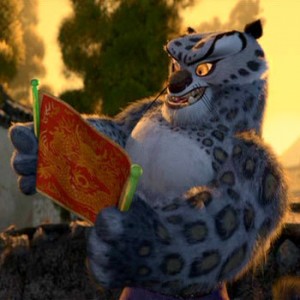
Tai Lung plays the part of a villain, but he's depicted as a bit more human in both behavior and appearance.
Enter the realm of mythology, and there’s a pretty surprising lack of clouded leopard stories. In my searching, I’ve only found one specific myth, taken from the Rukai people of Thailand. In the legend, the clouded leopard not only acts as a divine creature that leads them to a beautiful home, but as a skilled hunter, who provides the people with plentiful food. Thus, the people honor the clouded leopard, refusing to hunt it or wear its fur, teeth, or claws (The Head Louse Clan of the Clouded Leopard).
I noticed a generally positive portrayal of leopards in the other myths I read as well! For example, the fable How the Leopard Got His Claws depicts the leopard as a kind and noble king, who only becomes violent when his fellow animals betray him and choose the dog as their new king (Achebe). A similar portrayal appears in another fable, “How the Leopard Got His Spots.” In this story, the leopard kindly helps a tortoise down from a tree and in return receives his spotted coat, becoming the most beautiful animal in the jungle. It’s amazing how different both the leopard and clouded leopard are portrayed in indigenous cultures compared to western animated films!
Probably the most relevant representation of these cats in modern culture, however, is that of an endangered species in need of conservation. For example, the Point Defiance Zoo website expresses current issues facing the clouded leopard, such as poaching and habitat degradation. It emphasizes the protection of this animal and its habitat and the enforcement of wildlife protection laws. What this shows is that the clouded leopard is an important symbol in the conservation of habitats and endangered species alike (“Clouded Leopards,” Point Defiance Zoo & Aquarium).
The Clouded Leopard Project website shares this belief, providing information on the clouded leopard, while encouraging visitors to make a difference by spreading the word about these animals, avoiding palm oil products, and making donations to breeding and other conservation projects. It stresses the importance of these animals as an endangered species, viewing them in a highly positive light (“Clouded Leopard Status,” Clouded Leopard Project).
CHARACTER DESIGN WORK
In this class, we were instructed to come up with a series of character designs and model sheets based on observational drawings and the design principles of Disney and cartoon modern. Later on, we took what we learned from our designing and created two animations and a few zoetropes. Before I show off those flashy videos and gifs, though, here are some samples of the designs I created.
First, we were required to jot down a series of gesture drawings of our animal in order to understand the anatomy and motion and apply it to a ‘pure animal’ design. I wound up going way overboard and creating at least twenty pages of these sketches. For the sake of your sanity, here’s one that I think especially conveys the cubs’ behavior.
From there, I created a design based on the “pure animal,” using some of the positions I observed to create a somewhat simplified design. It wound up being a little more detailed than recommended, so I streamlined it during the animation process.
After that, we were instructed to create a few designs in the Disney or traditional character animation style. I’ve provided several of my brainstorming sketches for you to see in the gallery at the bottom of the page. Here is the design I created a sheet for. Unfortunately, it was a bit too ambitious for me to animate. Facial shots and a general structure can be found in the gallery at the bottom.
Afterwards, we were instructed to experiment in Cartoon Modern, a style that doesn’t conform to hyperrealism and rounded shapes, instead going for often more geometric, exaggerated, and weird looks. Both of my experimental pages can be found in the gallery, but I wound up choosing a simplified version of my villain, creating a simple zoetrope animation. Here is a gif of this character in motion.
After that, we went on to our two main animation projects…
ANIMATIONS
We were instructed to create two different animation assignments. One drawn by hand, one created with paper cut-outs. One was required to represent the pure animal, the other either a traditional cartoon, cartoon modern, or our own unique style. The clip you see above is my drawn piece, done in a simple traditional style. It features a cub waking up from a nap and pouncing on a ball. It took about fifty-three drawings to create, with several loops to make my job easier. Overall, I’m pretty pleased with the results.
This was my cut-out animal, meant to represent the “pure animal” aspects of the clouded leopard. It features an adult waking up from a nap, looking around, walking forward, pouncing, climbing up and down the screen, and eventually falling back asleep. It was a bit more challenging to create, simply because I needed to move each joint carefully to get the right motion across. And with a flimsy little puppet, that meant double checking to make sure the pieces were all set up properly. Luckily, I think it turned out okay.
CREATIVE WRITING
We wrote a number of pieces for this class, ranging from ekphrastic writing to essayistic pieces. Of all of these, I’ve decided to share my braided narrative, as it compiles what I’ve learned and observed into a single piece.
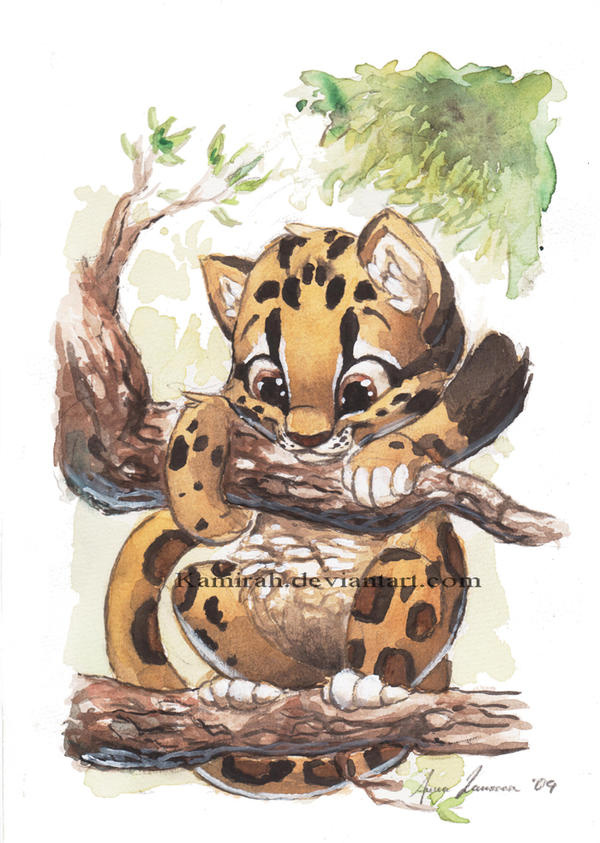
Art by Kamirah @ deviantART
I.
They have the largest canines of any cat. They are the modern saber tooth. Their coats bear a blotchy pattern, camouflaged among jungle shrubs. They are the hunters, the felidae, the carnivore. They devour other creatures with ease. Clouded leopard, the natural predator, neofelis nebulosa. Friend or foe, who truly knows?
II.
Leopard, clouded leopard, snow leopard. She lurks in the jungle, stalking prey, waiting for a chance to strike. When she sees the helpless family, she rips and tears with terrifying claws, devouring their hopes and dreams. Her clouded kin is much like her. When she hears of young babies in the woods, she hurries off in hopes of snatching one between her teeth. In a fantasy land full of talking beasts, the snowy-coated cat with kung-fu skills is above eating flesh, yet darkness festers inside his corrupted heart, and he selfishly longs for supremacy. They are the demons, the villains, the cold-hearted. They’re far from admirable creatures. Is everything so black and white, or is there something more?
III.
King Leopard beats his drum in the early morning, as the sun shines bright. When the animals gather around, he kindly assists them in building shelter. He is no ruthless killer, aiding the tortoise trapped in the treetops in return for his spotted coat. He is strong, but gentle and wise. His claws and fangs and roar weren’t always defining features. He only sought out these changes when the dog turned his fellow creatures against him, shunning him, driving him away while forcing him to return.
Misunderstood, misrepresented. He is the vengeful king who lost it all, the friend who faced betrayal, the tragic hero with a broken heart. Not the bloodthirsty beast. Not the self-absorbed fool. Within his broken heart, perhaps some good remains.
IV.
They stumble around with enormous paws, exploring their surroundings. Their sweet faces light up the moment food and company arrive. Their large canines are tiny daggers at best, far from threatening and fierce. They squirm, stumble, wrestle, climb, leap, roll, and stretch. The people all around don’t call them villains, beasts, or demons. To them, they’re babies, kittens, children, and most of all, cute. Their splotchy, golden coats hardly provide camouflage in their pastel den, and soft toys are their only prey. They are not a symbol to fear, to hate, and to dread. They’re tiny crumbs. They’re playful youths. Mischievous, noble, adventurous, and unafraid. So why the double standard?
V.
Maybe it’s my bias, or maybe it’s theirs. I see these two cubs and think of playful kittens and long to reach out, to pet them, to play in their little world. Sometimes I talk to them, although they cannot hear through the soundproof walls. I feel rewarded when I watch them play and interact with their keepers, blissfully batting at toys. There’s an innocence these animals display, for they know not the struggles of their wild relatives, whose habitats constantly dwindle away. Maybe that’s why I feel so enraged when cats of all kinds get portrayed as villains, killers, and cold-hearted. They eat meat, and they do kill, but it’s how they’re built. It’s necessary. One day, I hope others consider a new approach. One that looks beyond the idealized images of kings and the symbols bloodthirsty beasts to truly see the animals as they are, free from bestial ambivalence. Is this just a fleeting dream, or will it become reality?
IN CLOSING
This quarter has provided me with a chance to get to know an animal I only knew of in passing. Thanks to the research I’ve conducted and my long observation sessions, I have a new appreciation of the clouded leopard. Hopefully you’ve enjoyed reading through my experiences, studies, and checking out my images as well. If you want to learn more about these endangered cats, check out the Clouded Leopard Project! They provide excellent information about these animals and ways you can help contribute to their conservation.
Below you’ll find a number of images, including those I couldn’t squeeze into the text above. Enjoy!
IMAGE GALLERY
- Drawing of a clouded leopard from the cover of my animal book.
- Observational drawings of the cubs sleeping.
- Zoetrope metamorphosis animation.
- I took my cartoon modern design, simplified it further, and made this!
- Sketch of Chee Wit resting.
- A quick sketch of the cubs in play.
- Quick sketch of Chee Wit standing up.
- First sketch of cub habitat. Drawn during week 4.
- Colored sketch of sleeping cubs and an adult male’s face.
- Sketches of both cubs and Chan-sung’s markings from week seven.
- Detailed sketch of the cubs and some gesture work. Done during week 8.
- Rouse, Andy. “Clouded leopard baring teeth.” Photograph. ARKive. NHPA Limited. Web. 30 May 2012.
- A scene from the Rugrats Go Wild!, the only animated film with a clouded leopard.
- A series of gesture drawings I did during week 3.
- Some of the gesture drawings I did while watching the cubs during week 3.
- This is my pure animal model sheet. Colored with colored pencils.
- Quick color doodle I did in my animal book.
- Drawing of a pouncing cub in colored pencil.
- Gesture sketch of cubs in action.
- Gesture drawing of Chee Wit sitting down.
- Gesture drawing of Chee Wit standing.
- Gesture drawing of a cub in motion. Done week 2.
- More motion studies of the cubs.
- Motion studies for adult clouded leopards.
- Sketch of Chee Wit’s face.
- Rough motion drawing of an adult. May not be totally accurate.
- Done week 2. Chan-sung and Suksn cuddle together for a nap.
- Gesture drawing of one of the cubs rolling over.
- I tried to get an idea of the cubs’ anatomy with this sketch.
- The two cubs curl together on a blanket.
- A quick, colored sketch of a cub’s face.
- A pencil sketch of the large enclosure, complete with trees and logs.
- This is a sketch of the big enclosure, where Chee Wit occasionally hangs out.
- The keepers rearranged the cub den by week 5, and this is how it stayed for the remaining weeks of my observation.
- Another drawing from the large enclosure, focusing on the trees.
- Some doodles I did in my animal book of an adult clouded leopard.
- More cartoon modern experiments. The last one reminds me of Snagglepuss.
- Stylized versions of my villain design, done with a cartoon modern flare.
- A fern and a grassy plant, taken from the outdoor enclosure.
- A palm and small tree, as seen in the large enclosure.
- This was the rough design idea for my traditional animation, until I decided to make my puppet piece the pure animal.
- I wanted to do more detailed sketches of the cubs. When I caught them asleep during week 8, I jumped at the chance.
- I wanted to design a hammy, cartoon villain, so here he is!
- Some basic expression sketches, rough anatomy, and the character’s staff.
- I drew a rough walk cycle to help me create my animation. It proved very useful.
- A few Disney-ish designs I did before settling on my villain.
- Tai Lung plays the part of a villain, but he’s depicted as a bit more human in both behavior and appearance.
- This image was my first attempt at creating traditional character designs. Here you can see the original version of my villain character.
BIBLIOGRAPHY
Kamirah. “Clouded Leopard”. Painting. deviantART. deviantART. 2009. Web. 07 May 2012.
Rouse, Andy. “Clouded leopard.” Photograph. ARKive. NHPA Limited. Web. 30 May 2012.
Thompson, Claire. “Diard’s clouded leopard resting on board walks.” Photograph. ARKive. Web. 30 May 2012.
Rouse, Andy. “Clouded leopard baring teeth.” Photograph. ARKive. NHPA Limited. Web. 30 May 2012.
“Clouded Leopards.” Point Defiance Zoo & Aquarium. Point Defiance Zoo & Aquarium. Web. 07 May 2012. <http://www.pdza.org/page.php?id=466>.
“Clouded Leopard Status.” Clouded Leopard Project. The Clouded Leopard Project. Web. 07 May 2012. <http://cloudedleopard.org/default.aspx?link=about_status>.
“The Head Louse Clan of the Clouded Leopard.” World Summit of Indigenous Cultures. Taipei Multicultural Arts Group. Web. 30 Apr. 2012. <http://indigenous.pristine.net/peoples/rukai/clouded_leopard_en.html>.
“Introduction to the Carnivora.” UCMP Berkley. University of California Museum of Paleontolog. Web. 07 May 2012. <http://www.ucmp.berkeley.edu/mammal/carnivora/carnivora.html>.
“Felidae.” Animal Diversity Web. University of Michigan. Web. 07 May 2012. <http://animaldiversity.ummz.umich.edu/site/accounts/information/Felidae.html>.
“Neofelis nebulosa.” Animal Diversity Web. University of Michigan. Web. 07 May 2012. <http://animaldiversity.ummz.umich.edu/site/accounts/information/Neofelis_nebulosa.html>.
“About the Clouded Leopard.” Clouded Leopard Project. Clouded Leopard Project. Web. 30 Apr. 2012. <http://www.cloudedleopard.org/default.aspx?link=about_main>.
CHRISTIANSEN, PER. “Species Distinction And Evolutionary Differences In The Clouded Leopard (Neofelis Nebulosa) And Diard’s Clouded Leopard (Neofelis Diardi).” Journal Of Mammalogy 89.6 (2008): 1435-1446. Academic Search Complete. Web. 30 Apr. 2012.
“Clouded Leopard (Neofelis nebulosa).” ARKive. Wildscreen. Web. 30 Apr. 2012. <http://www.arkive.org/clouded-leopard/neofelis-nebulosa/image-G7701.html>.
“Diard’s clouded leopard (Neofelis diardi).” ARKive. Wildscreen. Web. 30 Apr. 2012. <http://www.arkive.org/diards-clouded-leopard/neofelis-diardi/>.
The Rugrats Go Wild. Dir. John Eng and Norton Virgien. By Kate Boutiler. Perf. Bruce Willis, E.G. Daily, Tim Curry, Nancy Catwright, Lacey Chabert, Danielle Harris, Dionne Quan, Cheryl Chase, Michael Bell, Julie Kato, Menalnie Cartoff, Jack Riley, Jodi Carlisle, Joe Alaskey, Bob Bergen, Jim Cummings, Frank Welker. Nickelodeon Movies, 2003. DVD.
Tarzan. Dir. Chris Buck and Kevin Lima. By Tab Murphy, Bob Tzudiker, and Noni White. Perf. Tony Goldwyn, Minnie Driver, Rosie O’Donnel, Glenn Close, Brian Blessed, Lance Henriksen, Wayne Knight, Nigel Hawthorne. Walt Disney Pictures, 1999. DVD.
Kung Fu Panda. Dir. John W. Stevenson and Mark Osborne. Screenplay by Jonathan Aibel and Glenn Berger. Perf. Jack Black, Jackie Chan, Dustin Hoffman, Angelina Jolie, Ian McShane, Lucy Liu, Seth Rogen, David Cross, Randall Duk Kim, James Hong. Paramount Pictures Corporation, 2008. DVD.
Achebe, Chinua, and John Iroaganachi. How the Leopard Got His Claws. Nairobi: Heinemann Kenya, 1972. Print.
“How The Leopard Got His Spots.” Cricket 19.6 (1992): 28. MasterFILE Premier. Web. 30 Apr. 2012.


